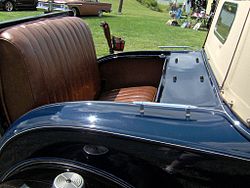Rumble seat

A rumble seat (American English), dicky seat, dickie seat or dickey seat (British English), also called mother-in-law seat, is an upholstered exterior seat which hinges or otherwise opens out from the rear deck of a pre-World War II automobile, and seats one or more passengers. An 1899 Century Dictionary describes a rumble as " A seat for servants in the rear of a carriage". Roadster, coupe and cabriolet auto body styles were offered with either a luggage compartment or a rumble seat in the deck. Models equipped with a rumble seat were often referred to as a sport coupe or sport roadster.
Rumble seat passengers were essentially seated out in the elements, and received little or no protection from the regular passenger compartment top. Folding tops and side curtains for rumble seats were available for some cars (including the Ford Model A) but never achieved much popularity. Among the last American-built cars with a rumble seat were the 1938 Chevrolet,[1] the 1939 Ford[2] and 1939 Dodge[3] and Plymouth.[4] The last British built car with a dickey seat was the Triumph 2000 Roadster made until 1949.
References
- ^ conceptcarz.com
- ^ Roush Automotive Collection.
- ^ Corporation, Chrysler. "allpar.com". allpar.com. Retrieved 2011-11-20.
- ^ Benjaminson, Jim (1930-04-08). "allpar.com". allpar.com. Retrieved 2011-11-20.
